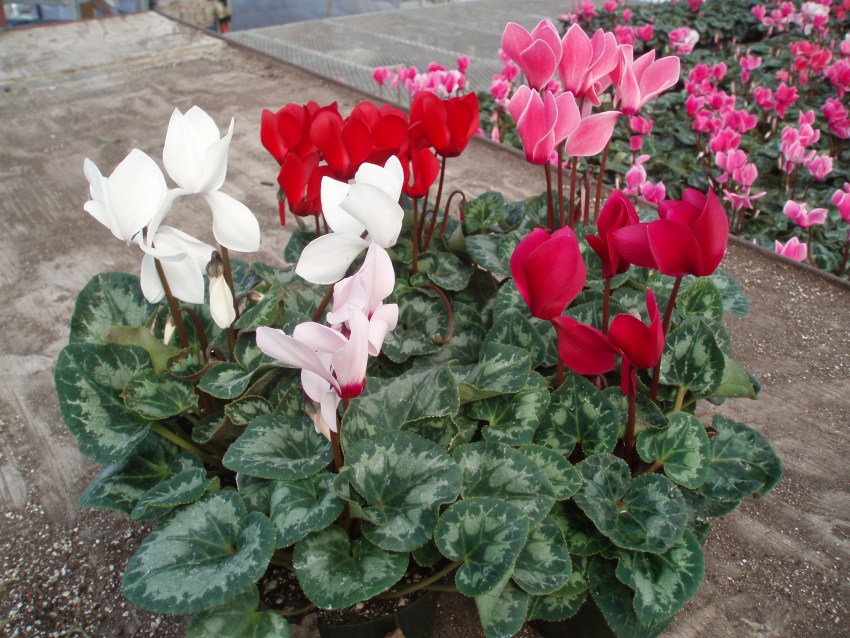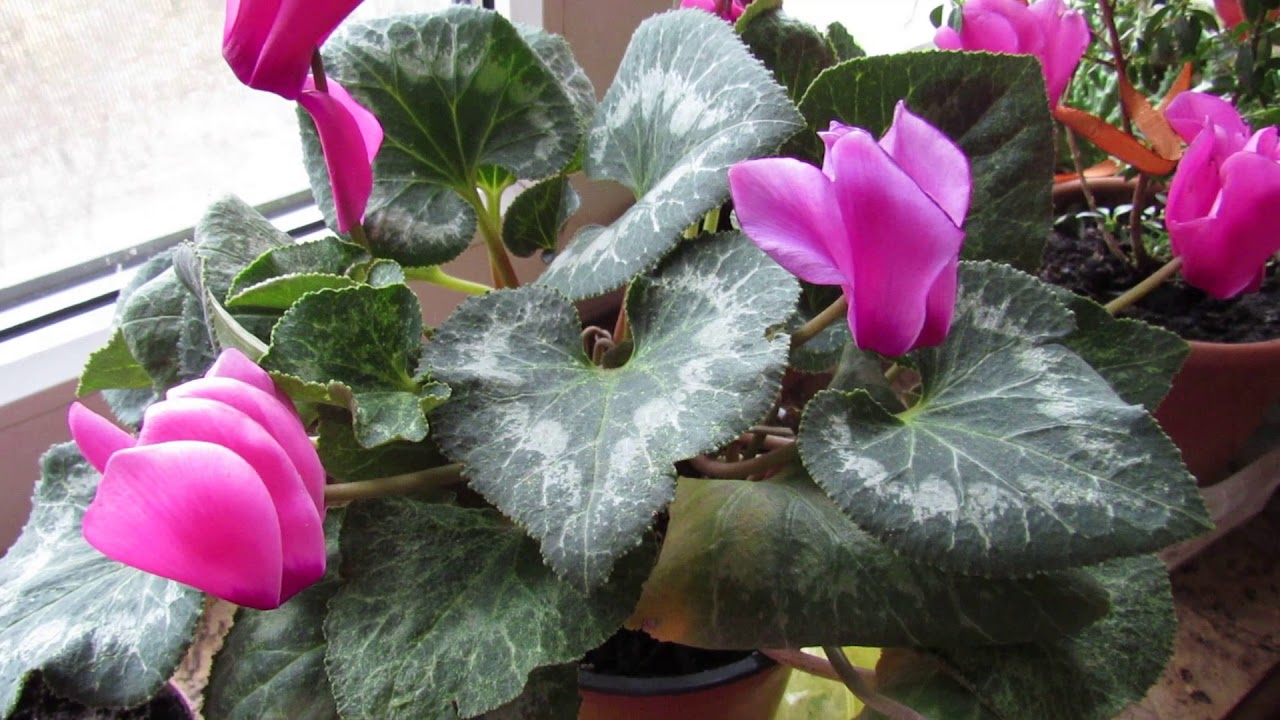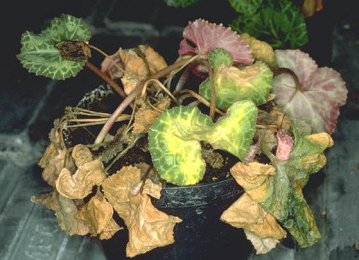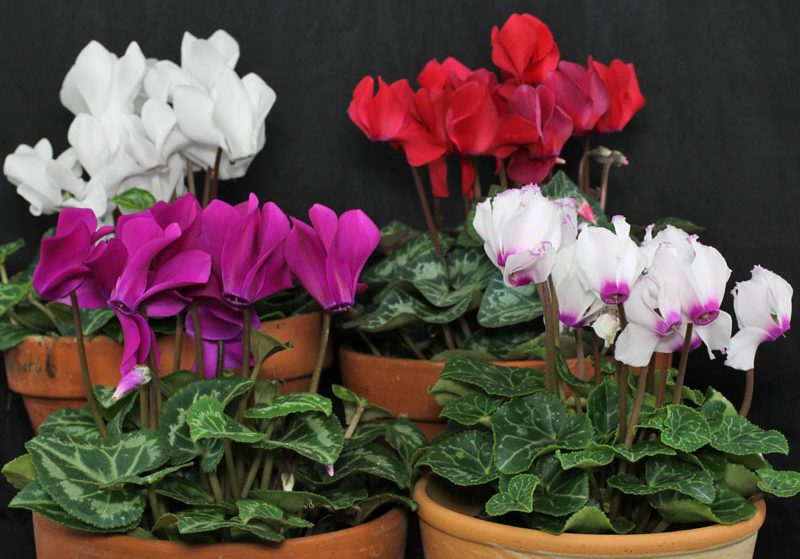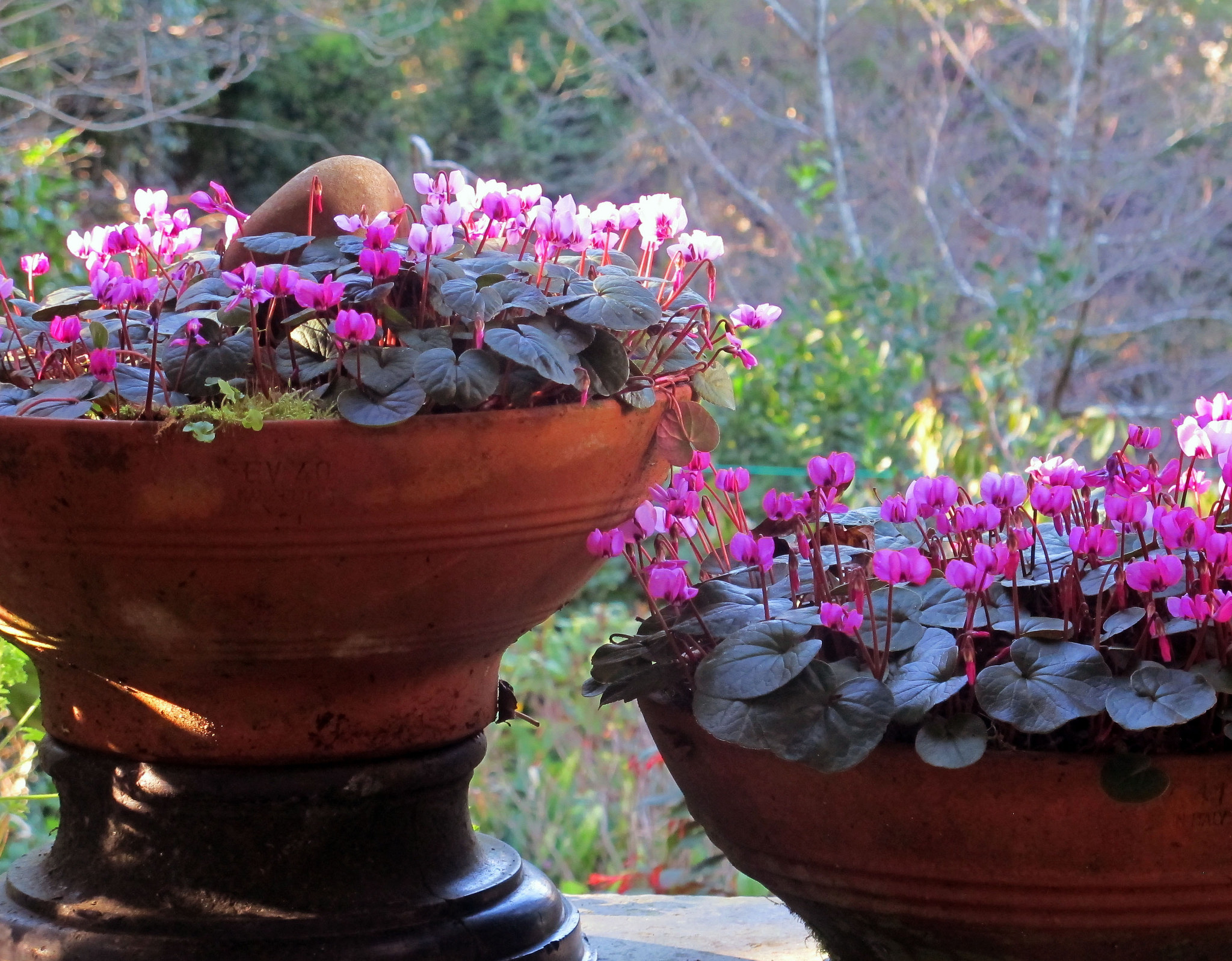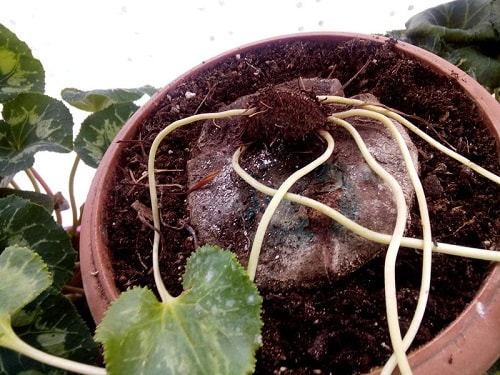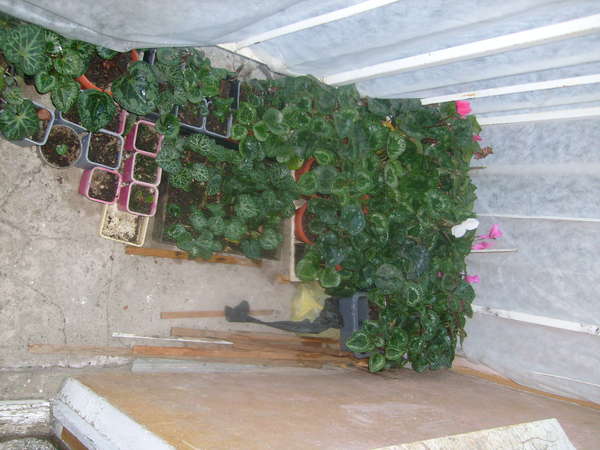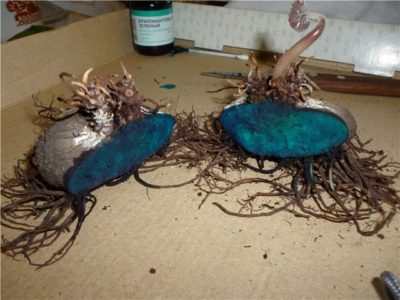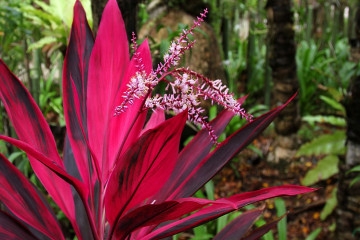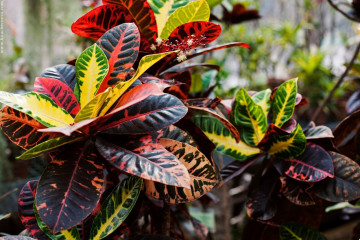Cyclamen: home care and breeding methods
Content:
The brightness and elegance of cyclamen is to the liking of many growers. The plant pleases its owners with flowering in the autumn-winter period. If cyclamen is cultivated, home care will require knowledge of certain nuances.
History of appearance
The cyclamen flower was known in ancient Rome as a decor for a courtyard and a house, a remedy for diseases and a talisman.
The rise in popularity of cyclamen occurs in 1939. In Ontario, a Canadian province, Lloyd Veit, a resident of Delhi, opens a small business - a flower shop. Formerly Flowers is today one of the largest flower suppliers in North America.
Farmley Flowers is a year-round cultivation of flower products that bloom in the fall with rainbow colors and graceful cyclamens.
In European countries, the cyclamen appears in 1650. This period is distinguished by the creation of hardy hybrid varieties and plant breeding everywhere.
Flowering period
If the cyclamen is grown at home, it can bloom luxuriantly for up to 15 years, forming about 70 luxurious flowers annually. The life span of one flower is 10 days. The large number of buds is responsible for the flowering duration - several months.
After wilting, the leaves, together with the peduncle, are carefully pinched off from the nodule. Cutting is undesirable. The fracture site is treated with charcoal.
The reasons why the leaves of cyclamen turn yellow include harmful insects and phyto-diseases. A careful examination will reveal the source of the illness. Often, improper care causes the development of rotting, attacks of cyclamen with a spider mite. It is important to take action in a timely manner.
Common varieties
The plant belongs to perennials from the Primrose family. It has 20 species. Cyclamen grows in the wild in the forests of south-west Asia, in the central part of Europe, in the Middle East.
In the common people, the flower is called dryad and pork bread.
The meaning of the last name is associated with the love of wild boars to feast on cyclamen tubers, digging out of the ground.
Cyclamen is an ephemeroid that blooms for a short time. Then the leaves of the culture dry up, and a dormant period begins.
Holland breeders have obtained many hybrid varieties of Persian cyclamen. Hybrids are characterized by a long flowering period:
- Caliph;
- Lulu;
- Victoria.
There are hybrid varieties of the European cyclamen. In demand among florists:
- Purpurascens;
- Album;
- Lake garda;
- Carmineolineatum.
Cyclamens are divided into 3 categories in height:
- standard - about 30 cm;
- medium-sized - up to 20 cm;
- undersized -15 cm.
The following types of crops, which differ in size, color and growing area, are distributed in nature:
- Persian. Distinctive features of the culture: the diameter of the nodule is up to 15 cm, the shape is flat-rounded. The rich green leaves have a heart shape and a silvery pattern. The stem reaches 15-20 cm in height.The flowers have a milky, pinkish or red hue. The length of the elongated petals is 5 cm. The Persian cyclamen blooms from autumn to March, sheds foliage in the summer. If Persian cyclamen is cultivated at home, care involves reducing watering to a minimum. Eliminate dried flower-bearing shoots and leaves. In August, a flower is transplanted into a new flowerpot and systematic watering is carried out. For indoor floriculture, plant hybrids have been developed.
- European. When growing alpine violets (as the flower is called differently), the size of the sheets is 3-4 cm. The lower side of the leaf has a purple color. The flowers are small, the petals do not exceed 2 cm. The inflorescences have a white, reddish or pinkish tone. The main differences between the European cyclamen are the period of decorativeness (May – September), the absence of a state of dormancy with drying leaves. In the summer season, they contain a flower at t = 25 ° C and with diffused rays of the sun.
- Cretan. Lives on the island of Crete. Characteristic features are compactness, white-pinkish colors.
- Kosky. Grows in the Caucasus. A tiny 10 cm cyclamen is not afraid of frost and hibernates under the snow. Pinkish red and white flowers have dark blotches at the base of the petals.
- Ivy. Neapolitan is also called. It is characterized by the appearance of flowers first, then sheets.
- African. Homeland - Tunisia and Algeria. Grows in bushy thickets. Leaves are heart-shaped, with a silver-green tint. They grow from a tuber, their length reaches 15 cm. Flowering begins in spring, ends in autumn, in addition, new foliage is formed only in September-November. For the winter, the plant is covered due to its low cold resistance.
- Caucasian. The culture is actively used in alternative medicine. The medicinal properties of Caucasian cyclamen are noted: it has a positive effect on digestion, restores strength after a cold. It is under the protection of the state, included in the Red Book of the Krasnodar Territory.
Agrotechnics
Dormant period
When cyclamen is bred, cultivation and care at home does not do without a dormant period. Drying and dying off of cyclamen leaves are associated with its onset. Inexperienced growers often get rid of the plant. They believe that cyclamen is a disposable crop that is not able to bloom every year.
It is advisable to reduce the frequency and intensity of hydration. It is recommended to carry out the procedure gradually. When the culture is completely exposed, watering is carried out rarely and little by little.
When dropping the last flowers, you will need to remove wilted buds and old dried leaves. In the spring, the culture is placed in a damp place and the moisture is stopped for a while.
During the dormant period, the storage of cyclamen at home is carried out in a different way: when the bush fades, irrigation is reduced, when the foliage dies off, the flowerpot is turned 90 °. So the plant is stored until the end of summer or the beginning of the autumn season.
When wilted flowers are removed, flowering time is prolonged, and new buds are formed. Correct execution of the manipulation is required. It is forbidden to pick, cut off old flower stems and foliage. They are twisted around the tuber, carefully, avoiding damage. If damage occurs, they are sprinkled with activated carbon.
Flower transplant
The planned transplantation of cyclamen at home is carried out after 3 years. The implementation of the procedure is determined by the type of plant: the European species is transplanted with the arrival of the spring season, in the fall - the Persian one. The transshipment method is suitable for manipulation. The transfer of culture to a new pot occurs with an earthen lump that is braided by roots. Only pour the earth into a voluminous flowerpot. Remember the drainage layer.
If you are transplanting flowers from a store, carefully clean the roots from the old soil. Fill a new container with a substrate for bulbous crops (Florin, Tulip). Use slightly acidic soil. For a young seedling, a flowerpot is suitable, the diameter of which is 7-8 cm, for a three - or five-year-old flower - 14-15 cm.
The tuber of a European individual is completely covered with soil when planting, a Persian - only 2/3. When the soil is of good quality, there is no need to fertilize the crop for 1-2 months.
Temperature
Cyclamen grows normally and blooms luxuriously in winter, when the temperature is + 10 ... + 14 ° С. In the warm season, the ideal temperature for a flower is + 20 ... + 25 ° С.
Watering
When leaving, it is important to know how to water cyclamen correctly. You will need soft water, which is 2 degrees below room temperature. Before watering, she is given a day to settle. Intense hydration is characteristic of the flowering period.
Prevent overdrying of the substrate in the flowerpot and liquid stagnation. Bottom watering, which is carried out in the pan, is suitable for the plant - moisture will not get on the buds, nodules, and the core of the bush. After moistening the culture, after 3 hours, remove excess liquid from the pan.
When flowering is complete, moisture is reduced. If the leaves wither completely, the tubers are exposed, watering is infrequent and insignificant.
The soil
When planting crops, use purchased soil. Suitable universal soil for geranium or Saintpaulia.
The addition of sand and perlite imparts looseness and moisture content. The soil for planting cyclamen is suitable with a neutral or slightly acidic pH level. If desired, prepare it yourself. You will need sheet soil (3 parts) and peat, manure, sand (1 part) taken in equal proportions.
The soil from the site is disinfected by calcining in a microwave oven or spilling a solution of potassium permanganate. For the drainage layer at the bottom of the tank, expanded clay is used along with gravel and pebbles.
Cyclamen containers are required from ceramics or plastic.
For adults, dishes with a diameter of 14-15 cm are useful, for young seedlings - less. The dishes for the plant are selected depending on the size of the nodule. The distance from the edge of the onion to the edge of the flowerpot is 2 cm. This will provide the indoor plant with optimal development and timely flowering.
Lighting
If cyclamen is grown, advice will be given on how to care for it correctly. To fully develop, culture needs light. Direct sunlight is often a threat to the plant. A window sill in the west or east is suitable. When placed on the south side, the flower is preferable to a place further from the window or shading. The north side is not the right place for cyclamen.
Reproduction techniques
Tubers
Before reproduction, the flower tuber must be dried. When cutting, the location on each lobe of the root along with the buds and leaves is important. The cutting site is smeared with brilliant green or sprinkled with activated carbon, then time is set aside for drying (2 days).
The parts are planted in moistened soil, placed in a lighted place and irrigated regularly. The adaptability is not 100%, some of the divisions rot.
Seeds
Artificial pollination will allow you to stock up on seed material from an indoor cyclamen. The manipulation is effective when carried out on a sunny morning, in addition to repeated repetition.
Before planting in the soil, the seed is soaked for 24 hours in Zircon (4 drops per 500 ml of liquid). To grow seedlings, you need a light loose soil. A container with holes at the bottom is required for the soil mixture. First, a 3 cm expanded clay layer is poured.Pour the prepared soil on top (6-7 cm). The earth is abundantly wetted. The seed is spread on the surface in 2 cm increments, sprinkled with a little earth. The container is covered with foil. Sprouts are expected from 1 to 3 months.
The soil needs watering and ventilation. First, a purple-pink nodule is formed on the surface. When a pair of leaves grows, the seedlings are dived and resettled into individual dishes. After 7-14 days, it is advisable to feed with complex fertilizer. Cyclamen bloom is expected a year. Flowers cultivated at home are distinguished by their hardiness and health compared to purchased individuals.
If cyclamens are grown, competent care is required. Acquaintance with the description of the flower and the nuances of growing and reproduction will help beginners to decorate the interior of the house and preserve its decorative effect for a long time.

